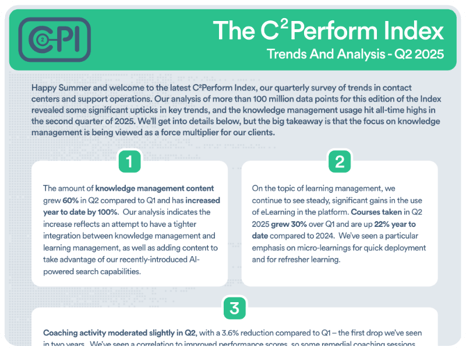Employee engagement is practically an evergreen topic for organizations of all sizes and industries. The Society for Human Resource Management (SHRM) noted that “Executives from around the world say that enhancing employee engagement is one of their top five global business strategies.”
But why is having an engaged workforce such a priority for business leaders around the globe? More importantly, how can you improve employee engagement within your organization?
Benefits of an Engaged Workforce
The benefits of having an engaged workforce have been extolled over and over again in countless articles. However, they still bear repeating just in case you need help convincing others that investing in employee engagement is a worthwhile use of your time and resources:
1. Improved Employee Retention
During the pandemic, most companies had to shift to new methods of work. But now disruption is coming from multiple angles - including the impact of AI. Whether it's due to retirement, external opportunities, relocation, or dismissals, turnover can be manageable. However, voluntary turnover is a different beast that can lead to serious staffing shortages if not enough skilled candidates are available to fill the gaps.
Recent insights from Harvard Business Review highlight a concerning trend: voluntary turnover isn't just a blip caused by recent disruptions but part of a longstanding increase over the past decade. It's not looking to reverse course anytime soon either.
So, what's a reliable way to tackle this persistent issue? Well, it boils down to ramping up employee engagement. According to Gallup, engaged employees are much less likely to leave—up to five times less likely, in fact, compared to their disengaged peers.
Investing in engagement isn't just about keeping your team happy on the surface; it's about forging a work environment where employees feel genuinely valued and see room for growth. This not only boosts morale but also organically cuts down your need to continually hire anew. In the long run, focusing on engagement helps stabilize your workforce and reduces the financial strain of high turnover.
2. Increased Productivity
An engaged employee is more likely to go the extra mile to meet the organization’s goals. They’ll stay on the line with customers longer, work harder to close deals, do more training in their spare time, and try to help others in their business unit meet their own goals.
Businesses with employee engagement rates in the top quartile saw an 18% increase in productivity and sales compared to ones in the bottom quartile (Source: Gallup). Gallup also noted that top organizations saw reduced absenteeism (81% less) and fewer quality defects in services and products (41% less).
An increase in productivity can make a major impact on a business's bottom line. Imagine if you could increase your organization’s profits by just 10% by engaging your employees more effectively. How valuable would that be to you and your organization? How about your investors?
3. Increased Customer Loyalty
It may surprise you to learn that there’s a correlation between customer loyalty and employee engagement. However, in organizations where employees regularly interact with customers—such as contact/call centers or traditional retail stores—the link is easy to see.
Gallup noted that organizations in the top quartile of employee engagement had 10% better customer loyalty and engagement than bottom-quartile organizations. This could be attributed to the level of dedication and service employees bring to each customer interaction.
A disengaged employee is less likely to try to help the customer. Instead, they’re liable to do the bare minimum to get the immediate “problem” off of their hands and pass it along to someone else. Meanwhile, an engaged employee will provide higher-quality service that makes the customer feel more appreciated.
Studies indicate that “positive experiences generate 140% more customer spending with a company over time” (Source: Walker Info). Because engaged employees are more likely to generate positive experiences, they’re more likely to generate customer loyalty and increased spending.
Example Employee Engagement Ideas
Considering the potential benefits of high employee engagement, it’s easy to see why it’s a primary focus of so many organizations. The question is: “How can you increase employee engagement in your organization?”
There are a few employee engagement ideas you could use to help make your employees happier and more willing to put in the extra effort at work—such as:
- Providing Recognition for Outstanding Effort. Employees need to know when they’ve accomplished something worthy of praise. Failing to recognize outstanding effort and results can cause employees to stop making an effort. Providing recognition when an employee meets a particularly tough goal, introduces a useful idea to the workplace, or closes a high-value deal is important. Making this recognition public can also help to motivate other employees to try harder to make recognition-worthy contributions.
- Arranging Some Individual Time with Employees. Employees who spend six hours per week with their leaders have been shown to be “30% more engaged” at work (Source: Fast Company). However, in a large call center or other work environments with a high employee-to-manager ratio, arranging a full six hours of one-on-one time with every employee might be unrealistic. In these cases, it can help to arrange small group meetings or simply have quick chats with individual employees whenever there’s some free time for it. Even if you can’t manage six hours a week, just a little time and attention can go a long way.
- Collecting Feedback and Acting on It when Possible. It can help to collect feedback from employees about their workloads, work tools, and even the people they work with. Some employees may not be comfortable providing feedback, so you may want to set up a system for submitting anonymous feedback—like a blind suggestion box. You can take the best ideas or most pressing feedback and use it to make improvements in the workplace. This can help improve conditions so employees can be more productive and help employees feel like their input matters. If you have an anonymous feedback system, avoid calling out specific employees for feedback you get from it—even if you’re certain who submitted it based on what it is. Doing so can lead employees to believe that the system isn’t anonymous and that they may face retaliation for negative feedback. This defeats the purpose of an anonymous feedback system. However, be sure to provide recognition for good ideas submitted through other means, such as during your one-on-one sessions with employees or during public meetings.
- Connecting Work Tasks with Purpose. If you want to drive employee engagement, it can help to tie each employee’s work to a greater purpose or meaning that they can take pride in. As noted by Forbes, “Engaged employees are doing meaningful work and have a clear understanding of how they contribute to the company’s mission, purpose and strategic objectives.” The corollary of this is that if employees don’t understand how they’re contributing and feel that their work is meaningful, then they won’t be engaged. By connecting purpose to employee work, you can help employees feel more motivated to complete work and put in the extra effort.
- Avoiding Creating Double Standards. This is less an employee engagement idea and more of a way to prevent causing employees to become actively disengaged or hostile. Few things can frustrate employees as quickly as feeling that they’re working under a double standard of some kind. When setting rules for employees to follow, managers need to model the behaviors expected of employees to avoid giving the impression of a “do as I say, not as I do” mentality. When dealing with employees, managers need to be consistent in their behavior towards each individual and group. As noted in an article on Medium, “One of the most difficult challenges to effectively collaborating with a leader or manager is not knowing who is going to show up to the meeting today.” Erratic behavior or singling out certain employees for harsher treatment erodes trust and may result in other employees withdrawing from their leader for fear of inciting the leader’s wrath.
Driving employee engagement goes beyond simply providing donuts in the break room or holding pizza parties every now and again. These kinds of events can help foster a positive work culture, but they’re no replacement for consistent daily effort spent on building employee engagement.
Get Started with a Talent Management System!
Recognizing extraordinary effort, setting up some time for personal coaching and development, and tracking employee performance is easier said than done—especially when you’re trying to manage a large team. Having to go from one app to the next for tracking KPIs, reaching out to employees, taking coaching session notes, and setting up training can be disruptive to your own productivity. Worse yet, when the apps aren’t designed to work together and your custom APIs fail, you might end up missing important information.
It's time to make the change to a talent management system that combines everything you need under a single “super app” that does it all.
C2Perform is a super app developed for customer support operations that provides a full suite of performance management and employee engagement tools in a single resource—no need to create custom APIs or log in to a half-dozen different software solutions!
Need help maximizing employee engagement? Reach out to us to get started!
 English
English Español
Español





.png?height=350&name=Untitled%20(300%20x%20175%20px).png)



